5 Varieties of Wines For Beginners
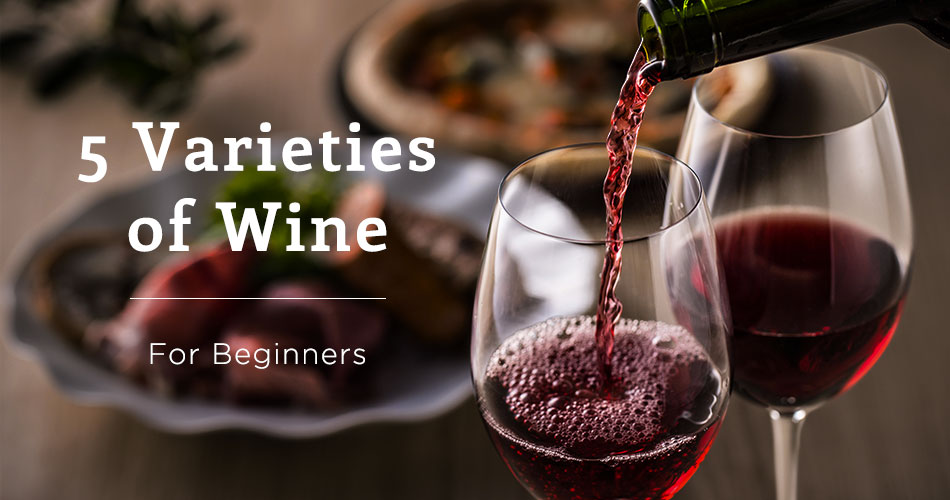
5 Varieties of Wine For Beginners
You may know your way around a liquor list and navigate craft beer menus with confidence, you may know what to wear on a date, but there’s something about wine that makes you feel as sophisticated as a caveman smashing rocks together. Sound familiar? If you haven’t already, you’ll one day find yourself in a situation where you are expected to order wine for the table or to bring a bottle to a dinner party — are you ready for that day? Do you know what food pairs with your choice? Do you know how strong it is, the flavors included, or even how to pronounce it?
See what we mean? There are a lot of opportunities for wine to make you feel ignorant but don’t worry, we’ve been there before and are here to help. We’re not going to try and write the book on wine (nor pretend we could), but here we’ll provide you the basics of a few can’t-go-wrong wines that should have you covered with most meals and situations. Plus, we’ll include miscellaneous talking points for each so you’re armed and ready to fake-it-until-you-make-it should the time come.
A Basic Primer On Wine Menus
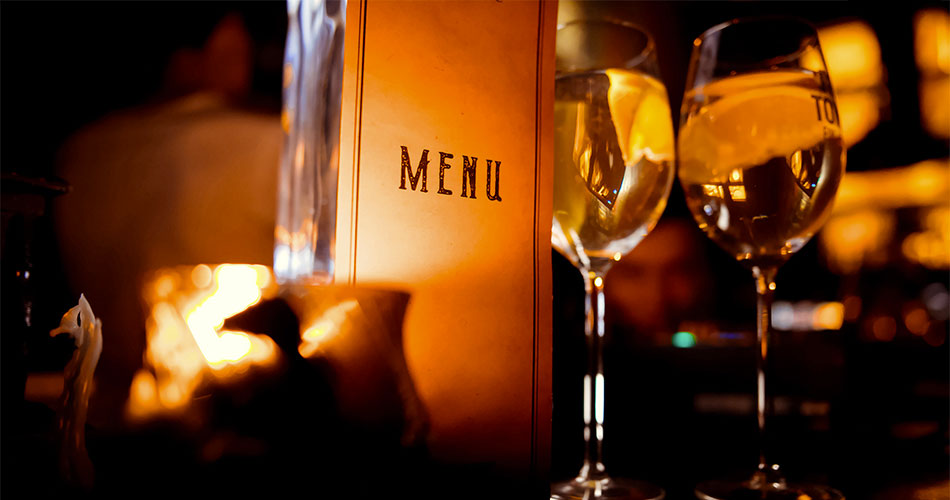
Before we get into the actual varieties, it’s important to go over some basics of interpreting a wine menu at a restaurant. Choosing wine for beginners can be difficult, but it starts simply. First and most importantly, the wine list will always be listed in order of lightest to most bull-bodied. Whether the whites and reds are combined in a shortlist or you’re looking at an extensive book at a fine dining establishment, this rule will always hold true. As you read the rest of this article and as you start exploring what suits your taste buds, keep this point in mind. It may come in handy in case you’re at a European dining establishment where the wines are presented by their regions of production rather than grape variety (as presented in this article). When in doubt, ask your server or sommelier for a recommendation on your preferred grape varietal and/or level of the body.
Another important point for novice wine drinkers is to order by the glass instead of by the bottle. While it may be true that ordering a bottle can be more cost-effective (individual glass pours tend to have higher mark-ups not to mention inconsistent levels of pour), unless you’re in a large group, the glass is the way to go. You’re just starting out in your vino explorations and in case you order incorrectly, you’re not stuck with an entire bottle of something that isn’t agreeable. In fact, most well-designed wine lists will have several options of both white and red varietals on offer by the glass that is typically crowd-pleasers.
Dress better. Live better. Pursue better.
Sign up for style, relationship, and self-improvement advice for the sophisticated modern man.

Finally, a note on wine prices. The prices we list below will be what you can expect if you purchase a bottle at a wine shop. Expect something like a 3x mark-up on that price at a restaurant for the same bottle. With a 4x mark-up for a by-the-glass pour, the glass pour is typically priced about what the bottle would cost at a wine shop. Yes, wine can be expensive – but pricier doesn’t always mean it’ll be tastier or even that it’s appropriate for your meal. We’ll cover pairings below but don’t judge a wine by its price. It’s more important to stick to the varieties you like and to your budget.
Five Wines For Beginners To Choose At The Table
The main types of wines to order for the table when you’re out.
Light White: Sauvignon Blanc

- Pronunciation: soh-vi-nyohn blahngk (the hard ‘k’ at the end is optional as it’s spoken by Americans and much of the world but is omitted by native French speakers)
- Alcohol Content: 10%–13.5% ABV
- What To Pair It With: fish, herb sauces, green vegetables
Light, dry white wines – like sauvignon blanc – are some of the most-sold wines in the world and are usually characterized as crisp and refreshing, with less ‘sweetness’ than a semi-dry white wine. Sauvignon blanc typically features simple flavors that include citrus fruits, kiwi, and honeydew melon and a tart, herbaceous quality (green pepper, mint, grass). It’s served chilled and pairs well with lightly flavored foods.
The grape is a signature of New Zealand wines, but it’s also a major player in France, Italy, Australia, Chile, and South Africa. Sauvignon blanc is an ideal wine to sip on in the summer months. Most sauvignon blanc wines drink best when they’re relatively young. Surprisingly good bottles can be had for less than $10.
Full-Bodied White: Chardonnay
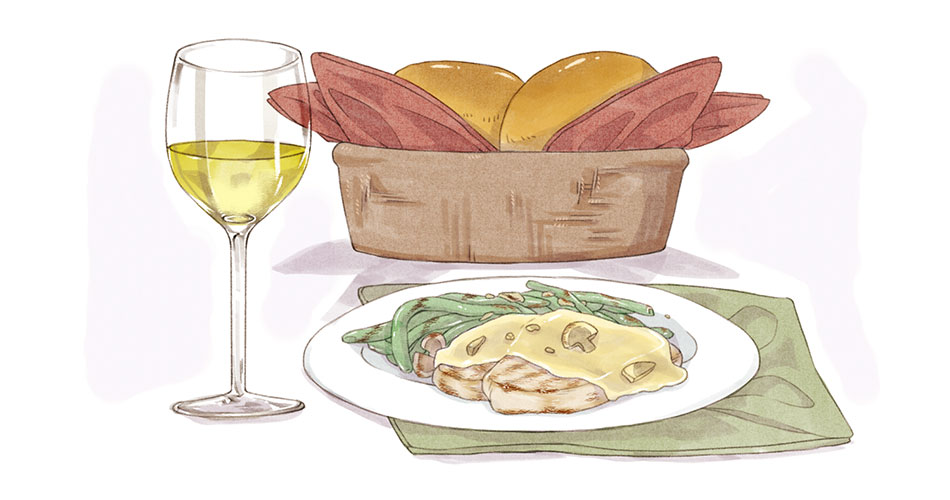
- Pronunciation: shar-doh-nay
- Alcohol Content: 13.5%–15% ABV
- What To Pair It With: mild cheeses, shellfish, chicken, fruity desserts
Full-bodied wines are characterized by being rich, complex, and well-rounded.e. Chardonnay boasts a distinctive buttery aroma, velvety feel, and a delightfully complex flavor profile thanks to being aged in oak barrels. b
Tasting notes for chardonnays include apple, pear, yellow citrus, tropical fruits, and often touches of butterscotch, bourbon, vanilla, or toasted caramel. Chardonnays contain a moderate alcohol percentage and are best paired with richer flavors.
This variety of white features heavily in the wine production of California, France, Italy, Australia, New Zealand, and South America. You can expect to spend $10-$40 on a good bottle.
Light to Medium Red: Pinot Noir

- Pronunciation: pee-noh nwar
- Alcohol Content: 11.5%–15% ABV
- What To Pair It With: duck, salmon, pork, veal, nutty cheeses
Pinot noir is a popular red variety with soft tannins. Tannins are a group of bitter and astringent compounds that exist naturally in vegetation, including in the skin, seeds, and stems of grapes. Whereas white wines only use the juice from grapes, whole grapes are used in the production of red wine, which is why red wines can be tannic. Without nerding out on tannins and their place in wine-making and wine flavor, just understand that too many tannins can cause a poor mouthfeel and result in a dry bitter taste that isn’t pleasant especially if it’s not balanced with a ton of fruit flavor.
Pinot noir grapes feature thinner skins and therefore have fewer tannins, allowing other flavors to shine. Pinot noir, in particular, expresses tons of red fruit flavor and oaky overtones. This is an “off-dry” or “semi-dry” wine, meaning it has slightly more sweetness than a dry wine but not enough to make it a syrupy dessert drink. In other words, you don’t have to be a hardcore red wine aficionado to enjoy it, meaning this type of wine is a safe bet to choose when you’re ordering for people with no firm stance on what type they prefer.
Pinot noir is one of the oldest grape varieties in the world and a hard one to master. First planted in France, it is now also widely planted in California, Washington, Oregon, Germany, and New Zealand. Pinot noir pairs especially well with red meats and other rich, textured foods like cheese. The average price for pinot noir can be higher than other varieties, but that hasn’t stopped it from cultivating legions of fans and becoming one of the most romanticized reds in the world.
Medium Red: Merlot
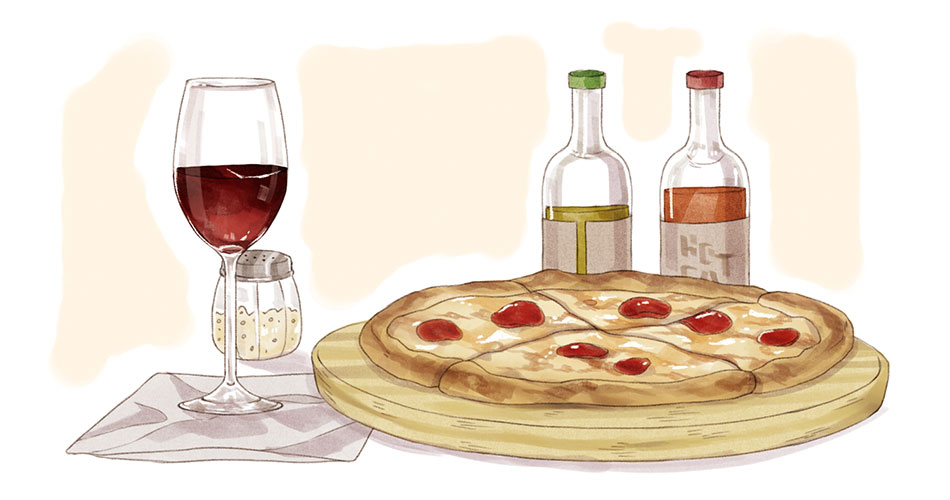
- Pronunciation: mehr-loh
- Alcohol Content: 13.5%–15% ABV
- Pair It With: poultry, roasted vegetables, rustic dishes and comfort foods like pizza, pasta, and BBQ
Despite its scathing mention in the 2004 film Sideways, which may have caused sales to take a temporary dip, merlot is one of the more popular varieties of red wine and a great type of wine for beginners to choose. Merlots are loved for their cherry flavors and chocolatey finish. A step-down from ‘full-bodied’, merlots are well balanced in flavor, featuring medium levels of tannins and thus pair with almost anything. This is easy, entry-level drinking.
Merlot grapes are cultivated in France, Italy, South Africa, various countries in Eastern Europe and South America, as well as the United States. Pro tip: don’t break the bank buying this one – go for the under-$20 bottles.
Full-Bodied Red: Malbec

- Pronunciation: maal-bek
- Alcohol Content: 13.5%–15% ABV
- Pair It With: lean red meats, steak, “funky” cheeses, umami flavors
Known for its juicy rich fruit flavors and smoky finish, Malbec is a full-bodied red packed with flavor and has exploded in popularity over recent decades. Malbec goes down well with or without food but is another excellent dinner choice as it pairs particularly nicely with full-flavored foods like lean red meats like lamb chops and steaks, sharp cheeses and creamy mushroom sauces.
The grape got its start in France before finding a new home in Argentina, yielding two variations of Malbec with distinct differences. French Malbec is savory and tart with firmer tannins. Argentinian varieties tend to be bolder, plummy and fruit-forward. Both malbecs are dry and rich, yet easy to drink and unpretentious. You can find introductory bottles in the $12-$20 range and more advanced bottles for $20-$50.
Three Wines For Beginners To Bring Home
What to serve when you’re the host.
Light White: Pinot Grigio
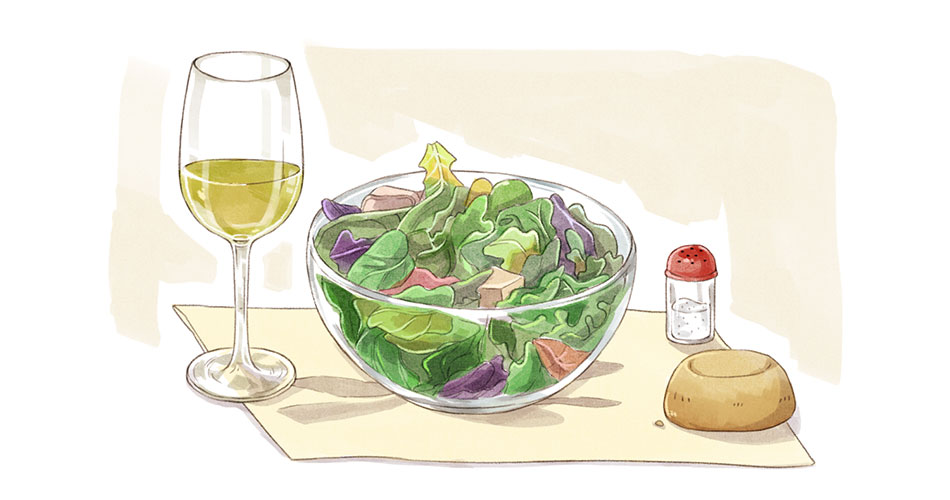
- Pronunciation: pee-noh gree-jo
- Alcohol Content: 10%–15% ABV
- Pair It With: Seafood, pasta with creamy sauces, fresh vegetables, and salads
If you’re only stocking one white, make it this crowd-pleaser.
Pinot Grigio (in Italy) or pinot gris (in France) is simple, light-bodied, dry and crisp with zesty notes of green apple and citrus. Though it’s far from the most complex wine out there, it’s easy on the palate and supremely drinkable with or without food.
Ready to indulge in a glass? Since you’re hosting the party, you’ll want to make sure you serve your wine correctly. Some are best chilled, some best room temperature. Here, serve the wine slightly chilled to make it the perfect refreshment on a hot summer day. If you have a variety of glass shapes to serve with, a pinot grigio does best in a vessel with a slender, U-shaped bowl that captures its delicate aromas and maintains a cooler temperature.
Pinot grigio is produced in countries all over the world, including France, Italy, Australia, New Zealand, and the west coast of the United States. Pick up bottles in the $15 to $20 range.
Full-Bodied Red: Cabernet Sauvignon
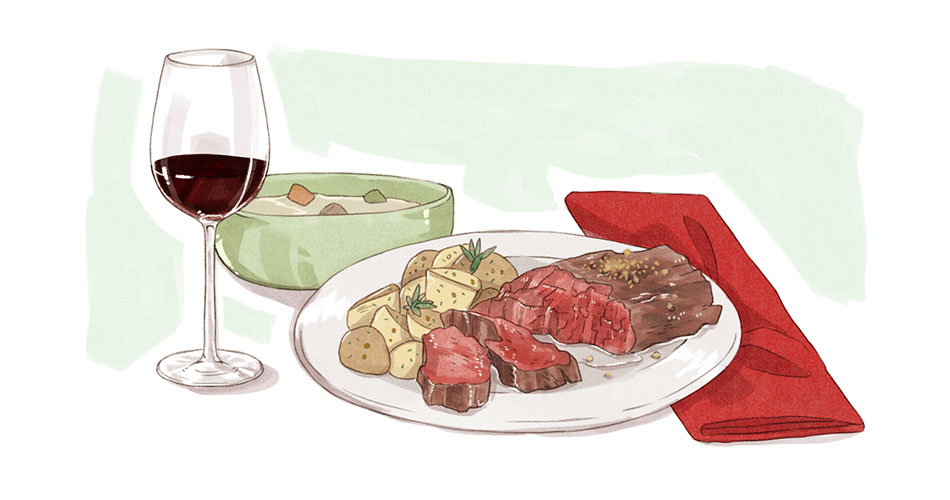
- Pronunciation: kab-er-nay soh-vi-nyohn
- Alcohol Content: 13.5%–15% ABV
- Pair It With: rich meats like rib roasts and fatty steaks, roasted potatoes, flavorful sauces
Every man needs a respectable red in his collection for those nights when he’s treating a loved one to some home-made steak. A cabernet sauvignon, or ‘cab’ as its affectionately referred to, is that red. Cabs are dry, full-bodied with bold tannins and bountiful flavor. Cabernet Sauvignon grapes are aged in oak barrels, a process that gives this wine notes of vanilla and chocolate in addition to a strong fruit component dominated by dark berries.
The flavor profile of an individual cabernet sauvignon will depend on its place of origin – famously France and California, but also South Australia, Chile, Argentina, and South Africa. Great bottles can be had in the $25 to $50 range.
Sparkling: Prosecco

- Pronunciation: pro-seh-ko
- Alcohol Content: 11%-12% ABV
- Pair It With: antipasto, cured meats, mild cheeses, sushi
Champagne (sparkling wine from the Champagne region of France) can be prohibitively expensive, New Year’s Eve may call for it, but any other day, keep your eyes peeled for prosecco, Italy’s affordable and accessible sparkling wine alternative. Prosecco contains fruity notes of green apple, honeydew melon, and pear with floral aromas and light, frothy bubbles. The finest proseccos hail from the hilly northeastern region of Valdobbiadene, and if you can remember that name when your guests ask, we commend you.
Prosecco is a quintessential pre-dinner celebratory drink, think ‘classy pre-game’, but it works equally well for your morning mimosa or any occasion that calls for a celebration. Enjoy it while it’s young and fresh and serve it cold in a tulip glass or flute. A decent entry-level prosecco can be found for $20 or less.
Time to Wine & Dine
Now that you know your way around a wine menu (or at least can pretend to), you can set aside your fears of getting the wine order wrong when the time comes. If you like what you read, be sure to subscribe to The Compass email list below! And, if you have any wine recommendations we didn’t list, or if you want to drop your favorite bottle choice, leave a comment below!
Your Next Move:
Like What You See? There's More.
We'll send you style advice and intel for the modern man.




Wonderful!
It really helped when you said that red wine goes well with steak or red meats. My friends and I are doing a wine and cheese night so I want to bring a good bottle to the party. Seems like a smart idea to choose an option that is widely liked. https://thewinefeed.com/collections/wine